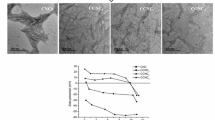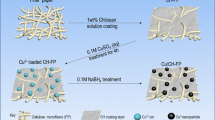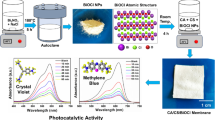Abstract
Performance of polymer-based Au catalysis depends on the size of Au particles and the structure of polymer host materials. In the current studies, the carboxymethyl cellulose-chitosan (CMC-CH) sheet was synthesized by layering CMC on CH sheet, while CMC-CH-CBV 780 zeolite Y (CMC-CHZY) sheet was synthesized by coating the CMC layer on a sheet of CH-incorporated CBV 780 zeolite Y (ZY). The CMC-CH or CMC-CHZY sheets were individually immersed in Au(III) salt solution, which was converted to Au0 NPs by treating with NaBH4 to synthesize Au/CMC-CH or Au/CMC-CHZY catalysts respectively. Both the synthesized Au catalyst activities were compared against the discoloration of methylene blue (MB) and Congo red (CR) dyes as well as the reduction of 4-nitrophenol (4-NP). It was revealed that Au/CMC-CHZY catalyst showed excellent catalytic performance against all the pollutants. Furthermore, the apparent rate constant kapp (3.3 \(\times\) 10−1 min−1), of Au/CMC-CHZY catalyst was found higher against MB dye discoloration as compared to CR and 4-NP. It was also observed that MB discoloration followed pseudo-first-order while CR and 4-NP followed the zeroth-order kinetics. The catalyst alters the mechanism of a chemical reaction and so does the order of the reaction, therefore, observed different orders of reaction in the current study.
Graphic abstract







Similar content being viewed by others
References
Ahmed S, Kamal T, Khan SA, Anwar Y, Muhammad TS, Asiri MA, Khan SB (2016) Assessment of anti-bacterial Ni-Al/chitosan composite spheres for adsorption assisted photo-degradation of organic pollutants. Curr Nanosci 12:569–575
Akhtar K, Khan SA, Khan SB, Asiri AM (2018) Nanomaterials and environmental remediation: a fundamental overview. Nanomater Environ Appl Fascin Attrib 2:1–36
Ali HSHM, Khan SA (2020) Stabilization of various zero-valent metal nanoparticles on a superabsorbent polymer for the removal of dyes, nitrophenol, and pathogenic. Bacteria ACS Omega 5:7379–7391. https://doi.org/10.1021/acsomega.9b04410
Ali N, Kamal T, Ul-Islam M, Khan A, Shah SJ, Zada A (2018) Chitosan-coated cotton cloth supported copper nanoparticles for toxic dye reduction. Int J Biol Macromol 111:832–838. https://doi.org/10.1016/j.ijbiomac.2018.01.092
Astrup T, Stipp S, Christensen TH (2000) Immobilization of chromate from coal fly ash leachate using an attenuating barrier containing zero-valent iron. Environ Sci Technol 34:4163–4168
Bakhsh EM, Khan SA, Marwani HM, Danish EY, Asiri AM, Khan SB (2018) Performance of cellulose acetate-ferric oxide nanocomposite supported metal catalysts toward the reduction of environmental pollutants. Int J Biol Macromol 107:668–677
Bello BA, Khan SA, Khan JA, Syed FQ, Mirza MB, Shah L, Khan SB (2017) Anticancer, antibacterial and pollutant degradation potential of silver nanoparticles from Hyphaene thebaica. Biochem Biophys Res Commun 490:889–894
Biffis A, Cunial S, Spontoni P, Prati L (2007) Microgel-stabilized gold nanoclusters: Powerful “quasi-homogeneous” catalysts for the aerobic oxidation of alcohols in water. J Catal 251:1–6
Cardenas G, Miranda SP (2004) FTIR and TGA studies of chitosan composite films. J Chil Chem Soc 49:291–295
Fernandes QM, Melo KRT, Sabry DA, Sassaki GL, Rocha HAO (2015) Does the use of chitosan contribute to oxalate kidney stone formation? Mar drugs 13:141–158
Ghosh SK, Pal T (2007) Interparticle coupling effect on the surface plasmon resonance of gold nanoparticles: from theory to applications. Chem Rev 107:4797–4862
Gu S, Wunder S, Lu Y, Ballauff M, Fenger R, Rademann K, Jaquet B, Zaccone A (2014) Kinetic analysis of the catalytic reduction of 4-nitrophenol by metallic nanoparticles. J Phy Chem C 118:18618–18625
Guo P, Tang L, Tang J, Zeng G, Huang B, Dong H, Zhang Y, Zhou Y, Deng Y, Ma L, Tan S (2016) Catalytic reduction–adsorption for removal of p-nitrophenol and its conversion p-aminophenol from water by gold nanoparticles supported on oxidized mesoporous carbon. J Colloid Interface Sci 469:78–85
Ishida T, Kuroda K, Kinoshita N, Minagawa W, Haruta M (2008) Direct deposition of gold nanoparticles onto polymer beads and glucose oxidation with H2O2. J Colloid Interface Sci 323:105–111
Kamal T, Khan SB, Asiri AM (2016) Synthesis of zero-valent Cu nanoparticles in the chitosan coating layer on cellulose microfibers: evaluation of azo dyes catalytic reduction. Cellulose 23:1911–1923
Kamal T, Ahmad I, Khan SB, Asiri AM (2019) Anionic polysaccharide stabilized nickel nanoparticles-coated bacterial cellulose as a highly efficient dip-catalyst for pollutants reduction. React Funct Polym 145:104395. https://doi.org/10.1016/j.reactfunctpolym.2019
Kamal T, Ahmad I, Khan SB, Asiri AM (2019) Bacterial cellulose as support for biopolymer stabilized catalytic cobalt nanoparticles. Int J Biol Macromol 135:1162–1170. https://doi.org/10.1016/j.ijbiomac.2019.05.057
Kamal T, Ahmad I, Khan SB, Ul-Islam M, Asiri AM (2019) Microwave assisted synthesis and carboxymethyl cellulose stabilized copper nanoparticles on bacterial cellulose nanofibers support for pollutants degradation. J Polym Environ 27:2867–2877. https://doi.org/10.1007/s10924-019-01565-1
Kanaoka S, Yagi N, Fukuyama Y, Aoshima S, Tsunoyama H, Tsukuda T, Sakurai H (2007) Thermosensitive gold nanoclusters stabilized by well-defined vinyl ether star polymers: reusable and durable catalysts for aerobic alcohol oxidation. J Am Chem Soc 129:12060–12061
Khan SA, Khan SB, Asiri AM (2015) Core–shell cobalt oxide mesoporous silica based efficient electro-catalyst for oxygen evolution. New J Chem 39:5561–5569
Khan SA, Khan SB, Asiri AM (2016a) Electro-catalyst based on cerium doped cobalt oxide for oxygen evolution reaction in electrochemical water splitting. J Mater Sci Mater Electron 27:5294–5302
Khan SA, Khan SB, Asiri AM (2016b) Layered double hydroxide of Cd-Al/C for the mineralization and de-coloration of dyes in solar and visible light exposure. Sci Rep 6:1–15
Khan SA, Khan SB, Asiri AM (2016c) Toward the design of Zn–Al and Zn–Cr LDH wrapped in activated carbon for the solar assisted de-coloration of organic dyes. RSC Adv 6:83196–83208
Khan SA, Khan SB, Kamal T, Yasir M, Asiri AM (2016d) Antibacterial nanocomposites based on chitosan/Co-MCM as a selective and efficient adsorbent for organic dyes. Int J Biol Macromol 91:744–751
Khan SB, Khan SA, Asiri AM (2016e) A fascinating combination of Co, Ni and Al nanomaterial for oxygen evolution reaction. Appl Surf Sci 370:445–451
Khan SB, Khan SA, Marwani HM, Bakhsh EM, Anwar Y, Kamal T, Asiri AM, Akhtar K (2016f) Anti-bacterial PES-cellulose composite spheres: dual character toward extraction and catalytic reduction of nitrophenol. RSC Adv 6:110077–110090
Khan SA, Bello BA, Khan JA, Anwar Y, Mirza MB, Qadri F, Farooq A, Adam IK, Asiri AM, Khan SB (2018a) Albizia chevalier based Ag nanoparticles: Anti-proliferation, bactericidal and pollutants degradation performance. J Photochem Photobiol B 182:62–70
Khan SA, Khan SB, Akhtar K, Farooq A (2018b) Nano-catalyst and nano-catalysis: state of the arts and prospects. Nanomater Environ Appl their Fascin Attrib 2:290
Khan SA, Khan SB, Khan LU, Farooq A, Akhtar K, Asiri AM (2018c) Fourier transform infrared spectroscopy: fundamentals and application in functional groups and nanomaterials characterization. In: Sharma SK (ed) Handbook of materials characterization. Springer, Berlin, pp 317–344
Khan SA, Khan SB, Farooq A, Asiri AM (2019) A facile synthesis of CuAg nanoparticles on highly porous ZnO/carbon black-cellulose acetate sheets for nitroarene and azo dyes reduction/degradation. Int J Biol Macromol 130:288–299
Khan SA, Baksh EM, Akhtar K, Khan SB (2020a) A template of cellulose acetate polymer-ZnAl layered double hydroxide composite fabricated with Ni NPs: applications in the hydrogenation of nitrophenols and dyes degradation. Spectrochim Acta A Mol Biomol Spectrosc 241:118671
Khan SA, Khan N, Irum U, Farooq A, Asiri AM, Bakhsh EM, Khan SB (2020b) Cellulose acetate-Ce/Zr@ Cu0 catalyst for the degradation of organic pollutant. Int J Biol Macromol 153:806–816
Kuroda K, Ishida T, Haruta M (2009) Reduction of 4-nitrophenol to 4-aminophenol over Au nanoparticles deposited on PMMA. J Mol Catal A Chem 298:7–11
Lee S-K, Mills A (2003) Novel photochemistry of leuco-Methylene Blue. Chem Commun. https://doi.org/10.1039/B307228B
Liu W, Yang X, Huang W (2006) Catalytic properties of carboxylic acid functionalized-polymer microsphere-stabilized gold metallic colloids. J Colloid Interface Sci 304:160–165
Madhusudhan A et al (2014) Efficient pH dependent drug delivery to target cancer cells by gold nanoparticles capped with carboxymethyl chitosan. Int J Mol Sci 15:8216–8234
McKay G (1982) Adsorption of dyestuffs from aqueous solutions with activated carbon I: Equilibrium and batch contact-time studies. J Chem Technol Biotechnol 32:759–772
Mevold AH, Hsu WW, Hardiansyah A, Huang LY, Yang MC, Liu TY, Chan TY, Wang KS, Su YA, Jeng RJ, Wang JK (2015) Fabrication of gold nanoparticles/graphene-PDDA nanohybrids for bio-detection by SERS nanotechnology. Nanoscale Res Lett 10:1–7
Narayanan KB, Park HH, Han SS (2015) Synthesis and characterization of biomatrixed-gold nanoparticles by the mushroom Flammulina velutipes and its heterogeneous catalytic potential. Chemosphere 141:169–175
Njagi EC, Huang H, Stafford L, Genuino H, Galindo HM, Collins JB, Hoag GE, Suib SL (2011) Biosynthesis of iron and silver nanoparticles at room temperature using aqueous sorghum bran extracts. Langmuir 27:264–271
Noh J-H, Meijboom R (2015) Synthesis and catalytic evaluation of dendrimer-templated and reverse microemulsion Pd and Pt nanoparticles in the reduction of 4-nitrophenol: The effect of size and synthetic methodologies. Appl Catal A-Gen 497:107–120
Pradhan N, Pal A, Pal T (2002) Silver nanoparticle catalyzed reduction of aromatic nitro compounds. Colloids Surf A 196:247–257
Salama A, El-Sakhawy M, Kamel S (2016) Carboxymethyl cellulose based hybrid material for sustained release of protein drugs. Int J Biol Macromol 93:1647–1652
Sohni S, Khan SA, Akhtar K, Khan SB, Asiri AM, Hashim R, Omar AM (2018) Room temperature preparation of lignocellulosic biomass supported heterostructure (Cu + Co@ OPF) as highly efficient multifunctional nanocatalyst using wetness co-impregnation. Colloids Surf A 549:184–195
Villa A, Chan-Thaw CE, Prati L (2010) Au NPs on anionic-exchange resin as catalyst for polyols oxidation in batch and fixed bed reactor. Appl Catal B 96:541–547
Yang H, Hu Y, Cheng H (2016) Sorption of chlorophenols on microporous minerals: mechanism and influence of metal cations, solution pH, and humic acid Environ. Sci Pollut Res 23:19266–19280. https://doi.org/10.1007/s11356-016-7128-9
Zhan G, Huang J, Du M, Sun D, Abdul-Rauf I, Lin W, Hong Y, Li Q (2012) Liquid phase oxidation of benzyl alcohol to benzaldehyde with novel uncalcined bioreduction Au catalysts: high activity and durability. Chem Eng J 187:232–238
Zhang Z et al (2011) In situ assembly of well-dispersed gold nanoparticles on electrospun silica nanotubes for catalytic reduction of 4-nitrophenol. Chem Commun 47:3906–3908
Zhang M, Liu L, Wu C, Fu G, Zhao H, He B (2007) Synthesis, characterization and application of well-defined environmentally responsive polymer brushes on the surface of colloid particles. Polymer 48:1989–1997
Zhang Z, Sèbe G, Wang X, Tam KC (2018) Gold nanoparticles stabilized by poly (4-vinylpyridine) grafted cellulose nanocrystals as efficient and recyclable catalysts. Carbohydr Polym 182:61–68
Zhao X, Liu W, Cai Z, Han B, Qian T, Zhao D (2016) An overview of preparation and applications of stabilized zero-valent iron nanoparticles for soil and groundwater remediation. Water Res 100:245–266
Acknowledgements
The authors would like to thank Deanship of Scientific Research at Majmaah University, Saudi Arabia for supporting this work under Project No. R-1441-147.
Author information
Authors and Affiliations
Corresponding authors
Ethics declarations
Conflict of interest
The authors declare that they have no conflict of interest.
Electronic Supplementary Material
Below is the link to the electronic supplementary material.
Rights and permissions
About this article
Cite this article
Al-Ghamdi, Y.O., Khan, S.A. Stabilization of zero-valent Au nanoparticles on carboxymethyl cellulose layer coated on chitosan-CBV 780 zeolite Y sheets: assessment in the reduction of 4-nitrophenol and dyes. Cellulose 27, 8827–8841 (2020). https://doi.org/10.1007/s10570-020-03379-0
Received:
Accepted:
Published:
Issue Date:
DOI: https://doi.org/10.1007/s10570-020-03379-0




